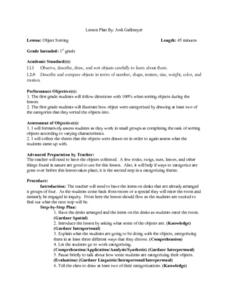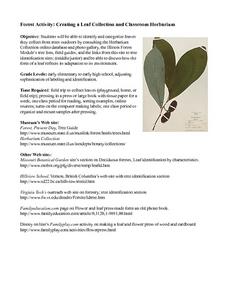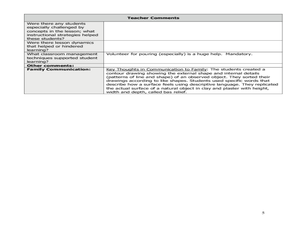Curated OER
Forest Activity: Leaf Collection and Creating a Herbarium
Students identify and categorize leaves. They collect leaves from trees, research the leaves using field guides and the Internet, press, label, and display the leaves, and discuss how the leaf reflects adaptation to its environment.
Curated OER
Plant Parts and their Function
Discover why plants are important to our world. View plant parts and categorize them as stems or buds. Students do a cut and paste of pictures of plants into correct categories. Students also plant a carrot top,and record...
Curated OER
Creating a Leaf Collection and Classroom Herbarium
Students categorize leaves they collect from trees outdoors by consulting a variety of sources. They discuss how the form of a leaf reflects its adaptation to its environment.
Curated OER
Categorizing Celestial Objects
Students work together to develop a classification system for planets. They take a class vote and read an article about an astronomer's classification system. They write an essay on how scientists make decisions for the general public.
Curated OER
How Can Plants Be Sorted?
In this plant classification worksheet, students will observe a variety of different plants and categorize each plant by its flowers, leaves, and spines. This worksheet had 13 fill in the blank questions.
Curated OER
Object Sorting
First graders follow directions when sorting objects. They illustrate how objects are categorized by drawing at least two of the categories that they sorted the objects into. Students work in small groups at completing the task of...
Curated OER
Introduction to Classification
Fourth graders design a classification system to categorize animate and inanimate objects. They discuss the advantages of grouping things as they classify buttons, leaves, shells.
Curated OER
Bug Sweep
Students observe and categorize insects. In this insects science lesson, students create a bug catcher out of a coat hanger and plastic bag, then collect bugs from the schoolyard. Students count and categorize the insects according to...
Alabama Learning Exchange
Classification
Students examine why scientists classify living organisms. They list and classify items they buy at the grocery store, sort and classify leaves, explore various websites, and write a biography of Carolus Linnaeus.
Curated OER
Social Studies and Economics
Students investigate the products agriculture provides in raw materials. In this agriculture products lesson, students make a list of common items used and foods eaten. Students work in teams to categorize agriculture products based...
Curated OER
The Great Pollinators
Young scholars discover the reproductive parts of a plant. In this biology lesson, students identify and categorize several different plants they dissect in class. Young scholars record their information using a data chart.
Polar Trec
Permafrost Thaw Depth and Ground Cover
The thaw depth of tundra creates a positive feedback loop with both global warming and the carbon cycle. Scholars sort photos and develop a hypothesis for ground cover and permafrost depth. Then they review the data and measurements...
Curated OER
Showing Nature's Way-Plant Development and the Plant Parts We Eat
Students explore plant life. In this science lesson plan, students demonstrate and record the stages of plant growth and categorize food plants by identifying the edible part.
Curated OER
Explore: 1st Grade Plant Observation
First graders grow seeds in a mini terrarium. They compare the root systems, stems, leaves, and flowers of the different plants. They categorize the plants and discuss the basic functions of plant parts.
Curated OER
ESL Pre-Intermediate Vocabulary Worksheet- Seasons
In this ESL pre-intermediate seasons worksheet, students place seasonal words into four lists. They categorize words into spring, summer, autumn/fall, and winter.
Curated OER
Chemistry: Metals and Non-Metals
Students conduct an experiment to test the reactivity of metals and non-metals. In this chemistry lesson students test metals with different chemicals to observe the reaction. The results are used to categorize the metals.
Curated OER
Making a Fossilized Egg
Students explore fossils by participating in an in class experiment. In this archaeology instructional activity, students utilize dough and classroom objects to create fossil imprints after hiding the toy/fossil in the dough egg....
Curated OER
Creating a Leaf Collection and Herbarium
Pupils gather and identify leaves for a collection. They discuss how a leaf's form reflects its adaptation to its environment. They press the leaves in a book and glue them on construction paper.
Curated OER
Plant Growth and Environment
Third graders bring to school various green plants and categorize them into plant leaves, stems, roots, and fruits. They answer the question, "How can you show there is starch in a plant?" and perform the iodine test and describe the...
Curated OER
Earth Epochs
Students explore earth epochs, i.e, Permian, Precambrian, Cambrian, Ordivician and through pictures they see what life on Earth and animals looked like. They organize Earth Epochs according to years going from greatest to least...
Curated OER
Explora-Pond: 1st Grade Shore Count
First graders experience addition through the exploration of a virtual pond. They categorize the various plants around the pond, count the number of various types of plants on the pond shore, and calculate the number of shrubs.
Curated OER
Five a Day
Students look up and print definitions of fruit and vegatable. They write down their food intake for three days. They identify and categorize fruits and vegetables. They research how fruits and vegetables grow. They bring in their...
Curated OER
A Pill with a View
Young scholars brainstorm a list of potential uses for micro-video technologies. After reading an article, they analyze the development of a new pill-sized camera. In groups, they create a children's book that shows them the various...
Curated OER
Plaster Casts of Natural Objects
Fourth graders observe objects in science and create a contour picture of the the object. For this arts and science observation lesson, 4th graders develop a clay sculpture of their object. Students generate a list of texture...























